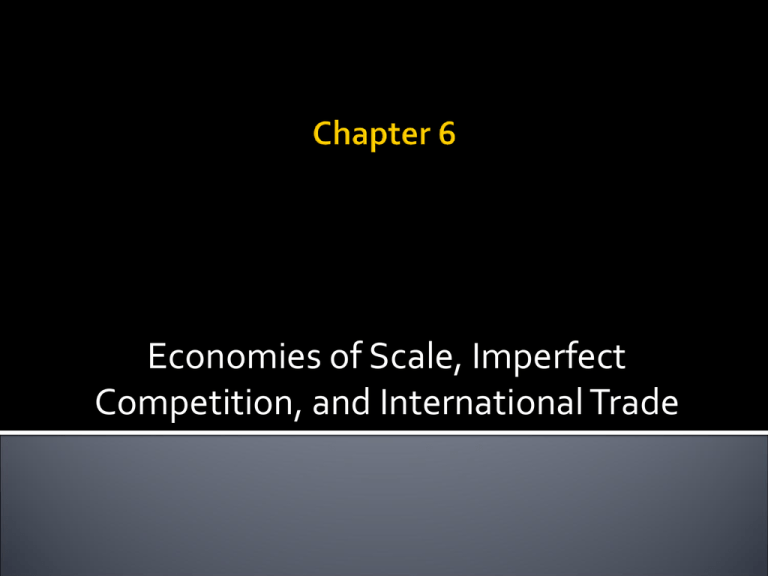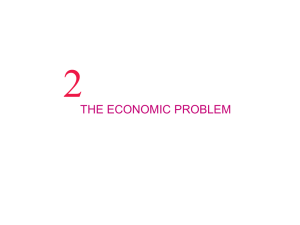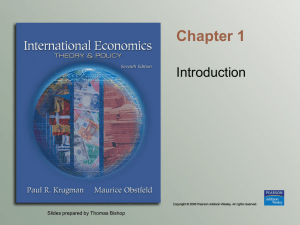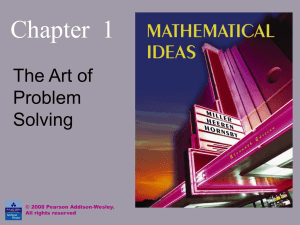
Economies of Scale, Imperfect
Competition, and International Trade
Types of economies of scale
Types of imperfect competition
Oligopoly and monopoly
Monopolistic competition
Monopolistic competition and trade
Inter-industry trade and intra-industry trade
Dumping
External economies of scale and trade
Copyright © 2009 Pearson Addison-Wesley. All rights reserved.
6-4
Why do countries that have similar capital, labor,
and land ratios trade with each other?
52% of German exports to France are things that
France also produces (intra-industry trade)
Why do countries have “industrial”,
“agricultural”, and “technology” sectors in
distinct geographical locations?
Night-time satellite photos of Europe reveal
distinctive contours of economic activity: bright lights
cluster around metropolitan centers (e.g. Brussels,
Amsterdam, and Dortmund)
Copyright © 2009 Pearson Addison-Wesley. All rights reserved.
6-5
When defining comparative advantage, the Ricardian and
Heckscher-Ohlin models assume that production processes
have constant returns to scale:
When factors of production change at a certain rate, output increases
at the same rate.
For example, if all factors of production are doubled then output will
also double.
In reality, a firm or industry may have increasing returns to
scale or economies of scale:
When factors of production change at a certain rate, output increases
at a faster rate.
A larger scale is more efficient: the cost per unit of output falls as a
firm or industry increases output.
Copyright © 2009 Pearson Addison-Wesley. All rights reserved.
6-6
The Ricardian and Heckscher-Ohlin models predict that all
income from production is paid to owners of factors of
production: no “excess” or monopoly profits exist.
But when economies of scale exist, large firms may be more
efficient than small firms, and the industry may consist of a
monopoly or a few large firms.
Copyright © 2009 Pearson Addison-Wesley. All rights reserved.
6-7
Economies of scale could mean either that larger
firms or a larger industry is more efficient.
External economies of scale occur when cost per
unit of output depends on the size of the industry.
Internal economies of scale occur when the cost
per unit of output depends on the size of a firm.
Copyright © 2009 Pearson Addison-Wesley. All rights reserved.
6-8
External economies of scale may result if a larger
industry allows for more efficient provision of
services or equipment to firms in the industry.
Many small firms that are competitive may comprise a
large industry and benefit when services or equipment
can be efficiently provided to all firms in the industry.
Internal economies of scale result when large
firms have a cost advantage over small firms,
causing the industry to become “uncompetitive.”
Copyright © 2009 Pearson Addison-Wesley. All rights reserved.
6-9
A monopoly is an industry with only one firm.
Firm is a “price setter”: can choose market price or quantity of
production
An oligopoly is an industry with only a few firms
Pricing decisions are interdependent
Copyright © 2009 Pearson Addison-Wesley. All rights reserved.
6-10
Copyright © 2009 Pearson Addison-Wesley. All rights reserved.
6-11
Monopolistic competition is a model of an
imperfectly competitive industry which assumes
that
1.
Each firm can differentiate its product from the product
of competitors.
2.
Each firm ignores the impact that changes in its price
will have on the prices that competitors set: even
though each firm faces competition it behaves as if it
were a monopolist (e.g. gas stations).
Copyright © 2009 Pearson Addison-Wesley. All rights reserved.
6-12
A firm in a monopolistically competitive industry is
expected:
to sell more as total sales in the industry increase and as
prices charged by rivals increase.
to sell less as the number of firms in the industry increases
and as its price increases.
These concepts are represented by the function:
Copyright © 2009 Pearson Addison-Wesley. All rights reserved.
6-13
Q = S[1/n – b(P – P)]
Q is an individual firm’s sales
S is the total sales of the industry
n is the number of firms in the industry (“variety” of goods)
b is a constant term representing the responsiveness of a
firm’s sales to its price
P is the price charged by the firm
P is the average price charged by its competitors
Copyright © 2009 Pearson Addison-Wesley. All rights reserved.
6-14
Assume that all firms face the same demand
functions and have the same cost functions:
Thus in equilibrium, all firms should charge the same price:
P=P
Then, in equilibrium,
Q = S/n (each firm has equal share of the market)
AC = F/Q + c = F(n/S) + c
We need to determine: the average price and the
number of firms in equilibrium.
Copyright © 2009 Pearson Addison-Wesley. All rights reserved.
6-15
AC = F(n/S) + c
As the number of firms n in the industry increases,
the average cost increases for each firm because
each produces less.
As total sales S of the industry increase, the average
cost decreases for each firm because each produces
more.
Copyright © 2009 Pearson Addison-Wesley. All rights reserved.
6-16
Q S
1 n b ( P P )
P
S
n SbP
Sb
MR P
Q
Sb
Q
Sb
E q u ilib r iu m : M R M C
P
Q
c
Sb
P c
Q
Sb
B u t if P P , th e n Q
P c
S 1 n
1
nb
M o r e f ir m s
lo w e r p r ic e
Copyright © 2009 Pearson Addison-Wesley. All rights reserved.
6-17
Copyright © 2009 Pearson Addison-Wesley. All rights reserved.
6-18
Because trade increases market size, it decreases average
cost in an industry.
Industry sales increase with trade leading to decreased average costs:
AC = F(n/S) + c
Because trade increases the variety of goods that consumers
can buy under monopolistic competition, it increases the
welfare of consumers.
And because average costs decrease, consumers can also benefit from
a decreased price.
Copyright © 2009 Pearson Addison-Wesley. All rights reserved.
6-19
Copyright © 2009 Pearson Addison-Wesley. All rights reserved.
6-20
As a result of trade, the number of firms in a new
international industry is predicted to increase
relative to each national market.
But it is unclear if firms will locate in the domestic country
or foreign countries.
So Americans buy BMWs and Germans buy Ford
Consumers in both countries face larger variety and lower
prices (due to increased competition)
Both BMW and Ford face lower average costs due to larger
markets (and increased production)
Copyright © 2009 Pearson Addison-Wesley. All rights reserved.
6-21
According to the Heckscher-Ohlin model or Ricardian model,
countries specialize in production.
Trade occurs only between industries: inter-industry trade
In a Heckscher-Ohlin model:
The capital abundant domestic economy specializes in the production
of capital intensive cloth, which is imported by the foreign economy.
The labor abundant foreign economy specializes in the production of
labor intensive food, which is imported by the domestic economy.
Copyright © 2009 Pearson Addison-Wesley. All rights reserved.
6-22
Copyright © 2009 Pearson Addison-Wesley. All rights reserved.
6-23
Suppose now that the global cloth industry is described by
the monopolistic competition model.
Because of product differentiation, suppose that each
country produces different types of cloth.
Because of economies of scale, large markets are desirable:
the foreign country exports some cloth and the domestic
country exports some cloth.
Trade occurs within the cloth industry: intra-industry trade
Copyright © 2009 Pearson Addison-Wesley. All rights reserved.
6-24
Domestic country is capital abundant and has a
comparative advantage in cloth.
But it does not produce all varieties of cloth (in
absence of trade, production is limited by the
scope/size of the market)
It should therefore export and import cloth with trade
Suppose that the trade in the food industry
continues to be determined by comparative
advantage.
Copyright © 2009 Pearson Addison-Wesley. All rights reserved.
6-25
Copyright © 2009 Pearson Addison-Wesley. All rights reserved.
6-26
1.
Gains from inter-industry trade reflect comparative
advantage.
2.
Gains from intra-industry trade reflect economies
of scale (lower costs) and wider consumer choices.
3.
The monopolistic competition model does not
predict in which country firms locate, but a
comparative advantage in producing the
differentiated good will likely cause a country to
export more of that good than it imports.
Copyright © 2009 Pearson Addison-Wesley. All rights reserved.
6-27
4.
5.
The relative importance of intra-industry trade depends on
how similar countries are.
Countries with similar relative amounts of factors of production are
predicted to have intra-industry trade.
Countries with different relative amounts of factors of production
are predicted to have inter-industry trade.
Unlike inter-industry trade in the Heckscher-Ohlin model,
income distribution effects are not predicted to occur with
intra-industry trade.
Copyright © 2009 Pearson Addison-Wesley. All rights reserved.
6-28
About 25% of world trade is intra-industry trade
according to standard industrial classifications.
But some industries have more intra-industry trade than
others: those industries requiring relatively large amounts
of skilled labor, technology, and physical capital exhibit
intra-industry trade for the U.S.
Countries with similar relative amounts of skilled labor,
technology, and physical capital engage in a large amount
of intra-industry trade with the U.S.
Copyright © 2009 Pearson Addison-Wesley. All rights reserved.
6-29
Note: an index of 1 means that all trade is intra-industry trade.
An index of 0 means that all trade is inter-industry trade.
Copyright © 2009 Pearson Addison-Wesley. All rights reserved.
6-30
Dumping is the practice of charging a lower price for
exported goods than for goods sold domestically.
Dumping is an example of price discrimination:
the practice of charging different customers different prices.
Price discrimination and dumping may occur only if
imperfect competition exists: firms are able to influence market prices.
markets are segmented so that goods are not easily bought in one
market and resold in another.
Copyright © 2009 Pearson Addison-Wesley. All rights reserved.
6-31
Dumping may be a profit maximizing strategy because of
differences in foreign and domestic markets.
One difference is that domestic firms usually have a larger
share of the domestic market than they do of foreign
markets.
Because of less market dominance and more competition in foreign
markets, foreign sales are usually more responsive to price changes
than domestic sales.
Domestic firms may be able to charge a high price in the domestic
market but must charge a low price on exports if foreign consumers
are more responsive to price changes.
Copyright © 2009 Pearson Addison-Wesley. All rights reserved.
6-32
Copyright © 2009 Pearson Addison-Wesley. All rights reserved.
6-34
To maximize profits, the firm should sell a limited amount in
the domestic market at a high price PDOM , but sell in foreign
markets at a low price PFOR.
Since more can always be sold at PFOR , the firm should sell its products
at a high price in the domestic market until marginal revenue there
falls to PFOR.
Thereafter, it should sell exports at PFOR until marginal costs exceed
this price.
In this case, dumping is a profit-maximizing strategy.
Copyright © 2009 Pearson Addison-Wesley. All rights reserved.
6-35
Dumping (as well as price discrimination in domestic
markets) is widely regarded as unfair.
A US firm may appeal to the Commerce Department to
investigate if dumping by foreign firms has injured the US
firm.
The Commerce Department may impose an “anti-dumping duty,” or
tax, as a precaution against possible injury.
This tax equals the difference between the actual and “fair” price of
imports, where “fair” means “price the product is normally sold at in
the manufacturer's domestic market.”
Copyright © 2009 Pearson Addison-Wesley. All rights reserved.
6-36
Next the International Trade Commission (ITC)
determines if injury to the U.S. firm has occurred or
is likely to occur.
If the ITC determines that injury has occurred or is
likely to occur, the anti-dumping duty remains in
place.
See
http://www.usitc.gov/trade_remedy/731_ad_701_cvd/inde
x.htm
Copyright © 2009 Pearson Addison-Wesley. All rights reserved.
6-37
If external economies exist, a country that has a
large industry will have low costs of producing that
industry’s good or service.
Each firm in the industry may be small, but may
benefit from the over-all size of the industry
When external economies exist, industries tend to
be geographically clustered
Let’s find out why…
Copyright © 2009 Pearson Addison-Wesley. All rights reserved.
6-38
1.
Specialized equipment or services may
be needed for the industry, but are only supplied by
other firms if the industry is large and
concentrated.
For example, Silicon Valley in California has a large
concentration silicon chip companies, which are serviced
by companies that make special machines for
manufacturing silicon chips.
These machines are cheaper and more
easily available for Silicon Valley firms than for firms
elsewhere.
Copyright © 2009 Pearson Addison-Wesley. All rights reserved.
6-39
2.
Labor pooling: a large and concentrated industry
may attract a pool of workers, reducing employee
search and hiring costs for each firm.
3.
Knowledge spillovers: workers from different
firms may more easily share ideas that benefit
each firm when a large and concentrated industry
exists.
Copyright © 2009 Pearson Addison-Wesley. All rights reserved.
6-40
If external economies exist, the pattern of trade
may be due to historical accidents:
countries that start as large producers in certain industries
tend to remain large producers even if another country
could potentially produce more cheaply.
Copyright © 2009 Pearson Addison-Wesley. All rights reserved.
6-41
Copyright © 2009 Pearson Addison-Wesley. All rights reserved.
6-42
Trade based on external economies has an
ambiguous effect on national welfare.
There may be gains to the world economy by
concentrating production of industries with
external economies.
But there is no guarantee that the right country will
produce a good subject to external economies.
It is even possible that a country is worse off with trade
than it would have been without trade: a country may be
better off if it produces everything for its domestic market
rather than pay for imports.
Copyright © 2009 Pearson Addison-Wesley. All rights reserved.
6-43
Copyright © 2009 Pearson Addison-Wesley. All rights reserved.
6-44
External economies may also be important for interregional
trade within a country
Many movie producers are located in Los Angeles which produce
movies for consumers throughout the U.S.
Many financial firms are located in New York which provide financial
services for consumers throughout the U.S.
If external economies exist, the pattern of trade
may be due to historical accidents:
regions that start as large producers in certain industries
tend to remain large producers even if another region
could potentially produce more cheaply.
Copyright © 2009 Pearson Addison-Wesley. All rights reserved.
6-45
1.
2.
Economies of scale imply that more production at the firm
or industry level causes average cost to fall.
External economies of scale refer to the amount of production by an
industry.
Internal economies of scale refer to the amount of production by a
firm.
With monopolistic competition, each firm can raise prices
somewhat above those on competing products due to
product differentiation but must compete with other firms
whose prices are believed to be unaffected by each firm’s
actions.
Copyright © 2009 Pearson Addison-Wesley. All rights reserved.
6-51
3.
Monopolistic competition allows for gains from
trade through lower costs and prices, as well as
through wider consumer choice.
4.
Monopolistic competition predicts intra-industry
trade, and does not predict changes in income
distribution within a country.
5.
Location of firms under monopolistic competition
is unpredictable, but countries with similar relative
factors are predicted to engage in intra-industry
trade.
Copyright © 2009 Pearson Addison-Wesley. All rights reserved.
6-52
6.
Dumping may be a profitable strategy when a firm
faces little competition in its domestic market and
faces heavy competition in foreign markets.
7.
Economic geography refers to how humans
transact with each other across space, including
through international trade and interregional trade.
Copyright © 2009 Pearson Addison-Wesley. All rights reserved.
6-53
8.
Trade based on external economies of scale may
increase or decrease national welfare, and
countries may benefit from temporary
protectionism if their industries exhibit external
economies of scale either at a point in time or over
time.
Copyright © 2009 Pearson Addison-Wesley. All rights reserved.
6-54
Additional Chapter Art
Copyright © 2009 Pearson Addison-Wesley. All rights reserved.
6-55
Copyright © 2009 Pearson Addison-Wesley. All rights reserved.
6-56
Copyright © 2009 Pearson Addison-Wesley. All rights reserved.
6-57
Copyright © 2009 Pearson Addison-Wesley. All rights reserved.
6-58
Copyright © 2009 Pearson Addison-Wesley. All rights reserved.
6-59







